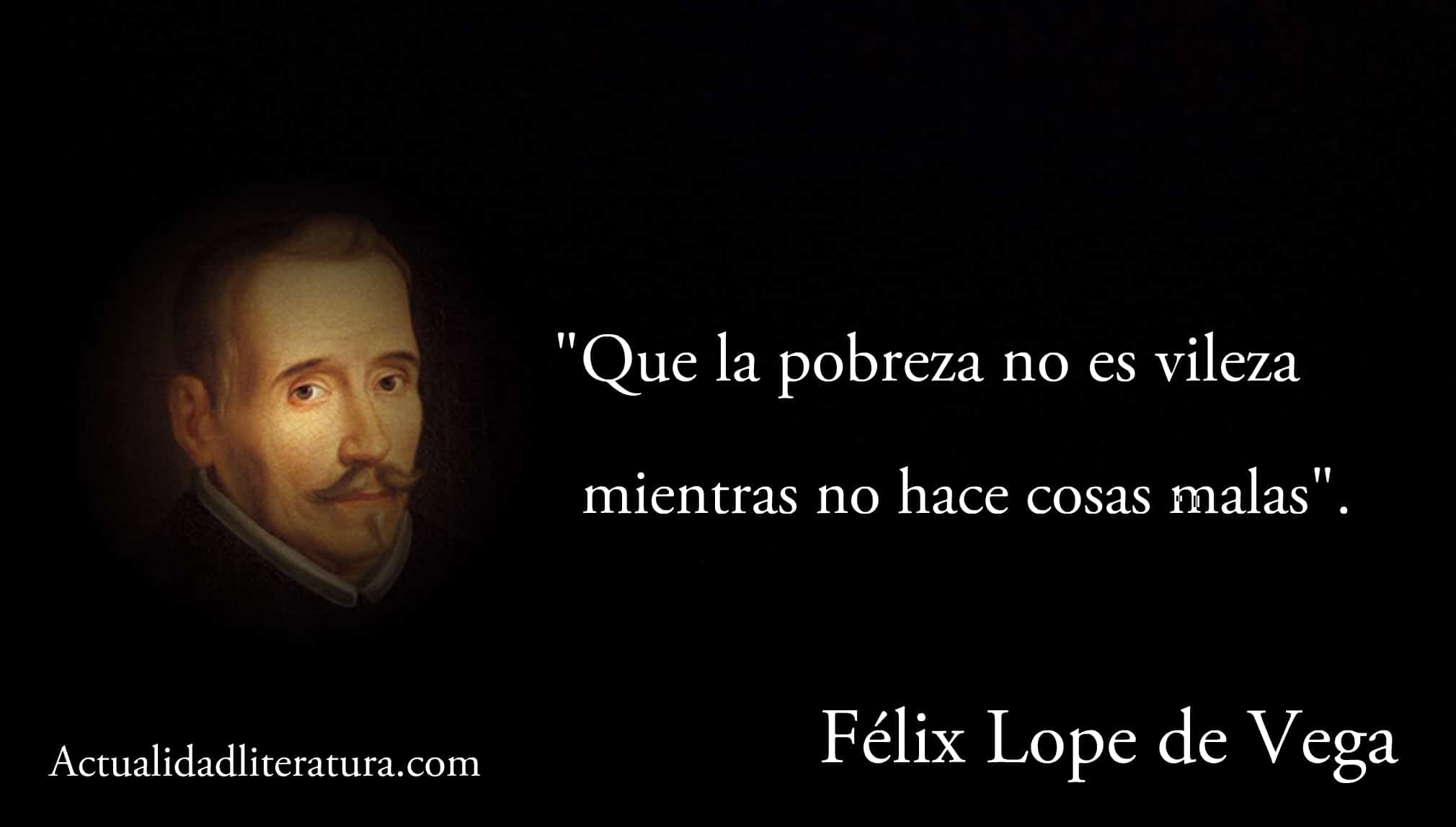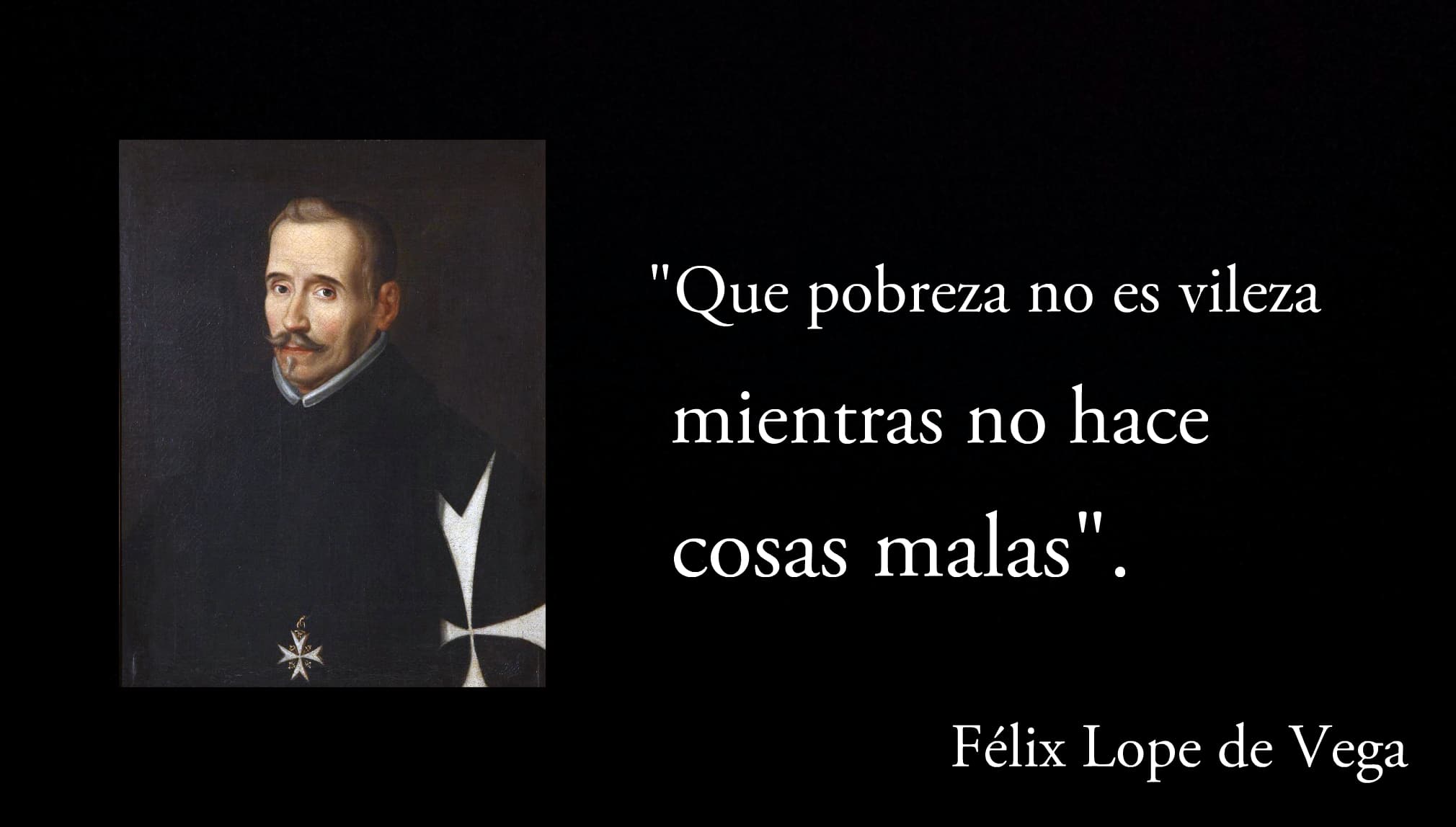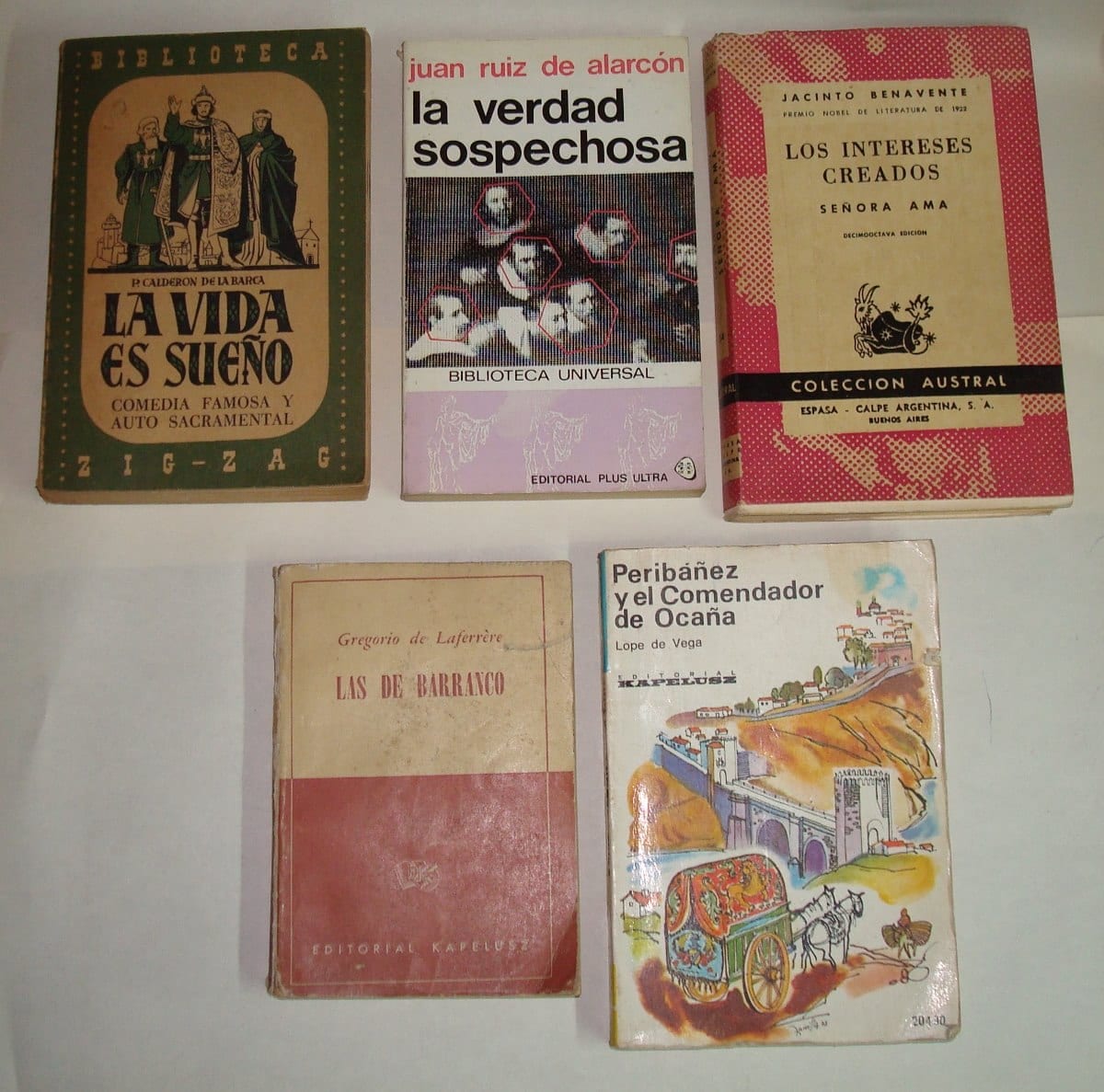
Phrase by Félix Lope de Vega.
Lope de Vega is one of the heroes of literature in the Castilian language. His name —along with illustrious figures such as Cervantes, Quevedo, Góngora and Molina, among others— is one of the protagonists of the so-called Spanish Golden Age. This century (which was actually more or less from 1492 to 1681) is considered the one with the greatest artistic and literary progress in Spain.
Nicknamed the "Fénix de los Ingenios", he knew how to win the recognition of the Spanish aristocracy of that period despite his controversies. Moreover, there were not a few events that transgressed social norms in which he was involved. At the same time, he was widely known for his facets as a conqueror, a cleric, an inquisitor and a prolific writer (he completed more than a thousand texts).
Birth, family, childhood and youth
The November 25 of 1562 (some historians indicate that it was December 2) Félix Lope de Vega y Carpio came into the world, in the bosom of a humble family stationed in Madrid. His parents, natives of the Cantabrian Mountains, were Félix de Vega —recamador by profession— and Francisca Fernández Flórez. Likewise, he had four siblings: Francisco, Juliana, Luisa and Juan.
According to the San Sebastián Archive, there were two more sisters: Catalina and Isabel. For her part, Vega spent her early childhood in Seville, together with her uncle —the inquisitor of the Andalusian city— Don Miguel Carpio. Later, he returned to Madrid when he was ten years old to begin a privileged instruction at the Colegio Imperial.
Infant prodigy
El Phoenix of Wits he was a really bright kid; from a very young age he was already able to read Spanish and Latin (in addition to translating the latter). At that time he also completed his early writing (mainly comedies like Hyacinth's pastoral, For example). After his fifteenth birthday, he began high school studies at the University of Alcalá.
Lively teenager, eternal student
In 1678 his father died; then, Felix showed a rebellious behavior and he ran away —accompanied by Hernando Muñoz, a close friend— of the family home. Despite such a "rogue facet", he was still eager for knowledge. For this reason, he deepened his knowledge in mathematics and astronomy under the tutelage of Juan Bautista Labaña, Philip II's greatest astronomer.
In addition, Lope learned Liberal Arts with Juan de Córdoba, philology with the Theatines and was secretary to the Marquis of Navas. To tell the truth, only death stopped the investigative habits of the Iberian intellectual in very diverse subjects. In parallel, he was always a poet with a very obvious weakness for women and adventures.
love and travel
an eternal lover
Lope de Vega's first known crush was María de Aragón, with whom he procreated a daughter, Manuela (1581 – 1586). Around the year 1582, the writer had an affair with Elena Osorio, a married lady. However, when she formalized her breakup with her husband—the actor Cristóbal Calderón—in early 1588, she preferred to marry a wealthy man.
Military career and exile
In 1582, the writer from Madrid moved to the Azores to enlist in the mission (which lasted less than a year) from the Marquis of Santa Cruz to Terceira. Later, he enlisted as a volunteer in the Great Army at the end of May 1588, this regiment was defeated by the Lusitanian militia.
At the end of the journey, Lope de Vega settled in Valencia with his wife, Isabel de Urbina, with whom he married on May 10, 1588. By that time, he was already banished from the Cortes of Madrid for eight years and two from the Kingdom of Castile. The cause: he indecently represented Elena Osorio in a dramatic piece when she suffered the sentimental disappointment described in the previous section.
Other couples, lovers and descendants of the eminent Spanish writer
Isabel de Urbina bore him two daughters: Antonia (1589 – 1594) and Teodora (1594 – 1596); the birth of the latter caused the death of her mother. In 1598, Lope remarried — for convenience, according to some historians — Juana de Guardo, who died of childbirth in 1613. Jacinta (1599), Carlos Félix (1606 – 1612) and Feliciana (1613 – 1633) were born from that marriage.
However, Vega was the lover of Doña Antonia Trillo de Armenta and the married actress Micaela de Luján. With the interpreter he fathered at least five (verifiable) children: Ángela, Mariana, Félix, Marcela and Lope Félix. Another notorious consort of the writer was Marta de Nevares, and as a result of that relationship Antonia Clara was born. In addition, two children whose mothers' identity is unknown are known:
- Fernando Pellicer;
- Fray Luis of the Mother of God.
Written work
Like other authors of his time, Lope de Vega unceremoniously ventured into all literary genres with obvious success. In fact, before he was 30 years old he was already a very famous character in Iberian territory. In this regard, Cervantes qualified it as The galatea as one of the most notable mills in Spain.
Most outstanding prose of Lope de Vega
- The Arcadia (1598), his first novel, includes several poems in a pastoral mood;
- The pilgrim in his homeland (1604), Byzantine novel;
- In the shepherds of Bethlehem (1612), pastoral novel with numerous sacramental poems;
- The Dorotea (1632); prose text with a wide poetic anthology in which he introduces the so-called celestinesco genre (originating from the humanistic comedy).
The lyrics of Lope de Vega
The Madrilenian poet was nurtured by many trends when assembling his poems and equally estimated different styles. For this reason, in his work there was room for the culterana metric (influenced by Luis de Góngora) and, in parallel, for popular lyrics. However, it is necessary to clarify that he was always a defender of "clear verse".

Phrase by Félix Lope de Vega.
Similarly, in his lyrics it is possible to find extensive poems with a narrative tone that can include parodic overtones. On the other hand, the Spanish poet did not hesitate to use different meters and genres within his short-structured poems. Following are the themes explored by Lope de Vega in his long poems (with some examples):
- epics: The Dragontea (1598) The Gatomachy (1634);
- Religious: The Isidro (1599) conquered jerusalem (1609) love soliloquies (1626);
- Mythological: the andromeda (1621) The Circe (1624)
Best-known short poems by Lope de Vega
- Rimas (1602);
- Sacred rhymes (1604);
- spiritual ballad (1619);
- Divine triumphs with other sacred rhymes (1625);
- Human and divine rhymes of the lawyer Tomé de Burguillos (1634);
- The Vega of Parnassus (1637), published post-mortem.
Some poems by Lope de Vega
"From Andromeda"
Tied to the sea Andromeda cried,
the nacres opening to the dew,
that in their shells curdled in cold glass,
in candid seed pearls bartered.He kissed the foot, the rocks softened
humble the sea, like a small river,
turning the sun into spring summer,
standing at its zenith he contemplated it.The hair to the boisterous wind,
to cover her with them they begged her,
since witness was of the same said,and jealous of seeing her beautiful body,
the Nereids requested their end,
that there are still those who are envious of misfortunes."Oh, bitter solitudes"
Oh, bitter solitudes
of my beautiful Phillies,
banishment well spent
of the wrong I did her!my years grow old
in these mountains that you saw,
that who suffers like a stone
it is well that in stones dwell.Oh sad hours
how different i am
the one you saw me from!With what reason I cry for you,
youthful thoughts
that at the beginning of my years
Near the end you tricked me!bad hand portrait,
changeable time you made me
no name they don't know me
though slowly look at me.Oh sad hours
how different i am
the one you saw me from!Letter has been suspicious,
that clear and dark serves,
that for not erasing it all,
above is overwritten.Sometimes I think I'm someone else
until the pain tells me
that who suffers so much
being someone else was impossible.Oh sad hours
how different i am
the one you saw me from!"Deadly Man"
Mortal man my fathers begot me,
common air and light from heaven gave,
and my first voice tears were,
that thus the kings entered the world.The earth and misery embraced me,
cloths, not skin or feathers, they wrapped me,
by guest of life they wrote to me,
and the hours and steps counted me.So I continue the day
to immortality the soul seized,
that the body is nothing, and pretends nothing.A beginning and an end has life,
because everyone's entrance is the same,
and according to the input the output.
Drama
The Madrid intellectual was a true innovator of the Spanish theater scene. Among the three structural foundations —action, time and location—, Lope only advised respecting the first in order to maintain credibility. Instead, he gave greater preponderance to absurd, tragic and humorous elements over chronology and place, especially in his historical pieces.
Additionally, much of the works Lope de Vega's plays demonstrate arguments inspired by love and honor. Likewise, he captivated all kinds of audiences (aristocrats, commoners, illiterate...) thanks to his double plot formula, one between the rich and the other between servants.
Some examples of their most frequent themes

Several books by Lope de Vega.
swashbuckling comedies
- La dama boba;
- Belisa's gingerbreads;
- The punishment of the discreet;
- The miracle knight;
- The unfortunate Estefania;
- Love without knowing who;
- The steel of Madrid.
knightly pieces
- Roland's youth;
- The Marquis of Mantua.
Religious
- The creation of the world;
- Dinah's robbery.
Historical
- Against value there is no misfortune;
- The Mudarra bastard.
Policies
- The Star of Seville;
- Ovejuna Fountain;
- The Knight of Olmedo.
The last stage of his life
Between 1598 and 1599, the author worked as a secretary to earn a living because the theaters were banned by royal order. First, he served the Marquis of Malpica, then the Marquis of Sarriá. In 1607, Lope began to work for the Duke of Sessa, Don Luis Fernández de Córdoba, this made him a close friend and protégé. During those years he spent his days between Madrid and Seville.
In 1608, the spanish intellectual began his path to the priesthood. In accordance, entered the Congregation of Slaves of the Blessed Sacrament and in the Third Order of Saint Francis.
That same year acquired a house in what is now Calle Cervantes (then it was Calle de Francos). There he resided until his death. happened on August 27, 1635.